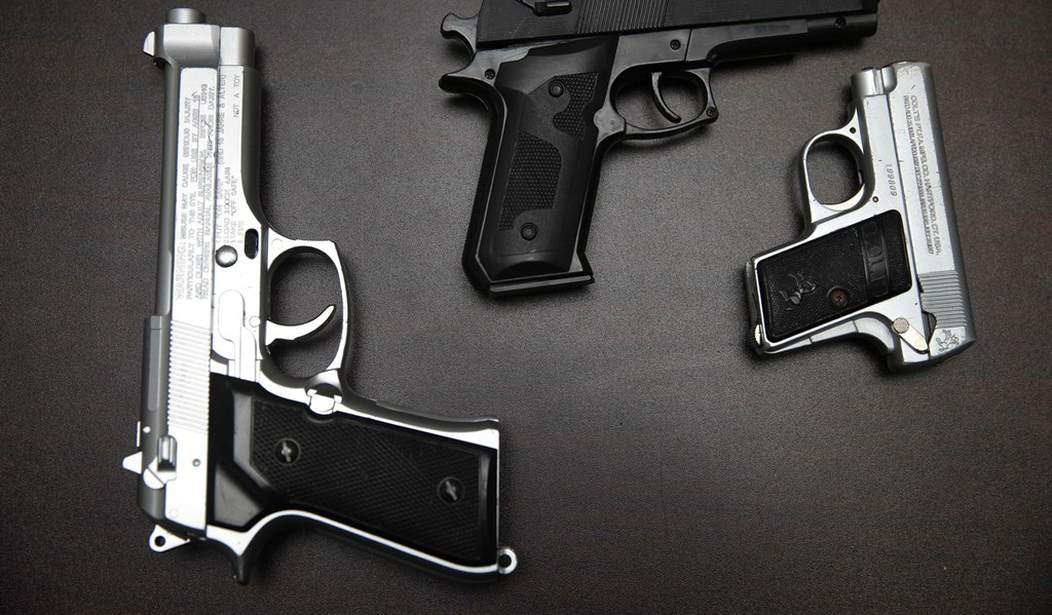Okay. To be fair, this piece wasn’t written by any of Politico’s staff writers or reporters, but it did show that this piece–written by two gun control advocates– pretty much ignored crime statistics from the Department of Justice and Pew Research.
Evan DeFilippis and Devin Hughes of ArmedWithReason.com, “a blog dedicated to academically refuting pro-gun myths, and providing a scholarly defense of gun control,” sought to debunk the “myth of defensive gun ownership.”
They start their piece by listing awful accidental shootings. Then, they analyze and cite errors in the 1992 study by Gary Kleck and Marc Getz–criminologists at Florida State University–who decided to surveyed the number of times firearms were used for defensive purposes:
In 1997, David Hemenway, a professor of Health Policy at the Harvard School of Public Health, offered the first of many decisive rebukes of Kleck and Getz’s methodology, citing several overarching biases in their study.First, there is the social desirability bias. Respondents will falsely claim that their gun has been used for its intended purpose—to ward off a criminal—in order to validate their initial purchase. A respondent may also exaggerate facts to appear
heroic to the interviewer.
Second, there’s the problem of gun owners responding strategically. Given that there are around 3 million members of the National Rifle Association (NRA) in the United States, ostensibly all aware of the debate surrounding defensive gun use, Hemenway suggested that some gun advocates will lie to help bias estimates upwards by either blatantly fabricating incidents or embellishing situations that should not actually qualify as defensive gun use.
Third is the risk of false positives from “telescoping,” where respondents may recall an actual self-defense use that is outside the question’s time frame. We know that telescoping problems produce substantial biases in defensive gun use estimates because the National Crime Victimization Survey (NCVS), the gold standard of criminal victimization surveys, explicitly catalogs and corrects for it.
…
These sorts of biases, which are inherent in reporting self-defense incidents, can lead to nonsensical results.
Recommended
The piece is essentially debunking the Gleck study, which is fine. They noted that even Gleck “admitted in 1997, in response to criticism of his survey, that 36 to 64 percent of the defensive gun uses reported in the survey were likely illegal—meaning the firearm was used to intimidate or harm another person rather than for legitimate self-defense.”
Then, we reach their conclusion:
But the evidence clearly shows that our lax gun laws and increased gun ownership, spurred on by this myth, do not help “good guys with guns” defend themselves, their families or our society. Instead, they are aiding and abetting criminals by providing them with more guns, with 200,000 already stolen on an annual basis. And more guns means more homicides. More suicides. More dead men, women and children. Not fewer.
Yeah, uh, that’s simply wrong. Besides that I could easily find hundreds of instances where guns were used in self-defense on GunsSavesLives.net, along with these other examples found here, here, here, and here; their “evidence” seems to have omitted research done by Pew and the Department of Justice.
Here’s some statistics from the Bureau of Justice Statistics from 2013 (via WaPo) [emphasis mine]:
The report, by the department’s Bureau of Justice Statistics, painted an encouraging picture of long-term trends at a time of divisive political debate over guns and legislation to regulate them. Firearms-related homicides declined 39 percent between 1993 and 2011, the report said, while nonfatal firearms crimes fell 69 percent during that period.…
Overall, the Justice Department report said, firearm-related homicides dropped from 18,253 homicides in 1993 to 11,101 in 2011, while nonfatal firearm crimes declined from 1.5 million in 1993 to 467,300 in 2011. The drop extended to schools: Homicides at schools declined from an average of 29 per year in the 1990s to an average of 20 per year in the 2000s.
Pew Research found that between 1993-2010, gun-related homicides dropped 49 percent, and they noted that Americans are largely unaware that they’re living in a time where gun crime is at a 20-year low [emphasis mine]:
National rates of gun homicide and other violent gun crimes are strikingly lower now than during their peak in the mid-1990s, paralleling a general decline in violent crime, according to a Pew Research Center analysis of government data. Beneath the long-term trend, though, are big differences by decade: Violence plunged through the 1990s, but has declined less dramatically since 2000.Compared with 1993, the peak of U.S. gun homicides, the firearm homicide rate was 49% lower in 2010, and there were fewer deaths, even though the nation’s population grew. The victimization rate for other violent crimes with a firearm—assaults, robberies and sex crimes—was 75% lower in 2011 than in 1993. Violent non-fatal crime victimization overall (with or without a firearm) also is down markedly (72%) over two decades.
…
Despite national attention to the issue of firearm violence, most Americans are unaware that gun crime is lower today than it was two decades ago. According to a new Pew Research Center survey, today 56% of Americans believe gun crime is higher than 20 years ago and only 12% think it is lower.
For an actual debate about guns in America, there needs to be two equally opposing sides. We don’t have that here because a) you can’t have a debate if the other side simply doesn’t do their homework and b) my side always wins.
There are areas of common ground both sides can agree on regarding firearms, like making sure the mentally ill don’t have access and reforming ways to detect and treat mental illness. Out of the past 62 mass shootings in America, mental illness was “rampant” amongst the vast majority–80 percent–of the perpetrators.
Then again, we should all take comfort that mass shootings aren’t on the rise either.

























Join the conversation as a VIP Member